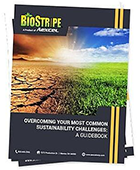How to Improve Sustainability Within Your Supply Chain
As companies embrace sustainability and environmental friendliness, they frequently look for solutions developed by their competitors and organizations outside their industry facing similar challenges.
However, sometimes an organization’s own supply chain can reveal some of the best practices and solutions. A company can often collaborate with its vendors, distributors, and customers to develop innovative environmental solutions. Switching to more sustainable packaging or eliminating environmentally harmful ingredients can result from collaboration within the supply chain.
Becoming Invulnerable to Scrutiny
Companies don’t operate in an insulated bubble. Seemingly endless information on a company or product is always only a few clicks or keystrokes away. If it exists, motivated individuals can locate just about any damaging information related to a company any link of its supply chain. Prudent supply chain managers should monitor the cogs on their supply chain to ensure they are following acceptable sustainable and corporate social responsibility practices.
Collaboration Is Essential
The supply chain represents more than quality products delivered on time at the right price. Suppliers should be transparent regarding production techniques and raw materials sources.
Consumers are placing an increased emphasis on sustainability in making their purchasing decisions. In fact, a Unilever study found that one in three consumers choose their brands based on sustainability. With this in mind, companies should work backwards through their supply chain to resolve challenges that compromise documentable sustainability.
Areas for Potential Improvement
Packaging
Changing inbound packaging to fully recyclable or reusable containers can reduce the carbon footprint substantially. This often requires considerable collaboration with suppliers.
Deliveries
Altering delivery frequencies can result in significant fuel savings and less wear and tear on the equipment. Likewise, rescheduling deliveries to reduced traffic periods can also save on fuel and reduce delivery time.
Raw Materials and Supplies
Replacing harmful raw materials can improve the ecological profile of products. Most ingredients in cleaning and architectural materials have been replaced by eco-friendly elements that are safer for people and the environment. For example, we’ve made durable and economical striping paint from soybeans rather than petroleum to create a low-VOC (volatile organic compound) coating that eliminates dangerous emissions and is far safer for humans to use.
Social Responsibility
The United Nations defined sustainability in 1987 as meeting present needs without compromising those of future generations. Achieving this definition on a global scale involves environmental, social and legislative responsibilities.
In this light, companies must make corporate social responsibility a factor in choosing their supply chain partners. This involves ensuring that products and raw materials are purchased from vendors that maintain high-quality standards for employee care and protection.
Since more companies are sourcing globally, monitoring both the environmental and social elements of the supply chain is an increasingly significant challenge.

Progress in Sustainability
Multifaceted initiatives toward sustainability, some originating at the very base of the supply chain, have resulted in widespread progress across many industries. Entire product categories such as cleansers and soaps, paints, HVAC equipment, automotive equipment and materials and insulation have undergone substantial retooling driven by sustainability. As a result, these industries now offer safer, better products for consumers. Most of these changes only came to fruition through collaborative efforts between the end marketer and their supply chain members.
Companies and suppliers that are continuously improving their environmental practices are thriving and growing. Companies that are resistant to change are being left behind by consumers seeking sustainable alternatives.


